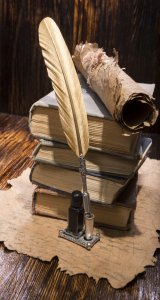Woodworking Tools: Right Selection And Care Will Save You Money, Part 3
Woodworking: Tools Of The Trade, Part 3 - Tools For Measuring & Marking
A civilization's maturity and intelligence is judged, in part, by the diversity and sophistication of its tools. When it comes to woodworking, the human race is quite advanced. There are general tools that work well in many situations, and there are specialty tools made for one specific purpose. There are tools that require only manpower and a rudimentary knowledge, and others that utilize computer programs, a wide range of knowledge, and a powerful motor. We have even learned how to harness power for our tools and package it in a small battery component, giving us the freedom to take our tools wherever we need them.
It is truly amazing and wonderful to contemplate the vast number of tools and all that woodworkers are capable of doing and creating with the help of these tools. And for many people, working with tools is one of the thrills, or even obsessions, of woodworking.
Woodworking and related tools have become so popular that there are numerous companies that manufacture these tools and thousands of places to purchase them. Combine that with the vast numbers of different types of tools and it can get overwhelming, especially if you are new to woodworking. Our experts helped us focus on the basics to develop an overview of those tools needed to get a good start in woodworking.
In the most basic terms, a woodworker needs four kinds of tools. They need a place to work, tools for cutting and shaping, tools for assembly, and finishing equipment. This simple statement provides the basis for the following discussion of woodworking tools.
The tools listed and described here represent just the tip of the iceberg. In keeping with the philosophy that it is best to learn the basics first, and to not invest large sums of money until a person is certain that they have an ongoing interest in woodworking, the emphasis is on hand tools, with a few basic power tools thrown in. These tools should prepare you for a variety of beginner projects and give you a solid foundation of equipment and knowledge to build upon.
Tools For Measuring & Marking
Most basic measuring tools are not complicated instruments that require special care. Yet making proper cuts is a key component of basic woodworking skills. It is important to have an accurate rule, a means of marking angles, and something to mark with.
Rulers
There are several types of rulers, but the most common are a metal tape measure, a 24-inch wooden folding rule and a wooden zigzag rule, which can be as long as eight feet. Tape measures have a long tape wound up inside the case and are especially handy for jobs with long pieces of wood. They also have a lock to hold the tape at the desired length.
Selection Tips
When buying wooden rulers, look for sturdy material with both standard and metric markings and a catch or pin for holding the rule closed when folded. Tape measures should also have both types of measurements and a sturdy tape. You should be able to find quality rulers for under $10. If buying used, be sure that all the numbers and markings are legible and that the spring to retract the tape measure and the lock to hold the tape are in working order.
Care & Maintenance
Most rulers simply need to be wiped down from time to time, especially the metal rulers that are susceptible to rust. Also with a metal tape measure, it is a good idea to hold the blade and let it return slowly back into the case. Simply releasing the lock and letting the blade whiz back inside can result in the tape coming unsprung.
Squares
A square is used to make angles and check for true and square joinings. It also has measurement markings. There are many different types and as with other tools, certain squares work best for certain types of tasks.
A miter square is for marking 45-degree angles. A try square is shaped like an "L" for marking 90-degree angles and checking for true squareness, and a sliding bevel is adjustable and is used with a protractor to mark angles up to 180 degrees. A combination square has settings for both 45 and 90-degree angles.
Selection Tips
Generally these three items will provide what you need for marking angles with reasonable accuracy. Those made from wood and metal are usually less expensive and slightly less accurate, but are fine for most general projects. You can purchase wood and metal squares at hardware stores or home centers for $10 to $15, although a good combination square may be quite a bit more.
Care & Maintenance
Squares are low maintenance tools. They need to be wiped down after use and the material should be checked periodically for rust or rot. The rivets or locking nuts should be checked for tightness and function. Beyond that, they don't require much additional maintenance.
Marking Tools
A sharp pencil can be used for marking, however many woodworkers feel that a marking knife is a better choice due to its superior accuracy. Unlike a pocketknife, a marking knife is beveled on one side and flat on the other to allow for a thin, straight mark. In addition, the small cut can help guide the cutting tool. A marking knife is one of the most inexpensive tools to purchase.
An awl, which is a sharp, pointed piece of metal attached to a round wooden handle, looks similar to an ice pick. It is typically used to mark or start nails and screws. Its sharp point can also be used to scratch a marking in a softer wood. Awls typically sell for under $10.
Some woodworkers use a marking gauge, which has a fence to keep it flush to the board and a writing tool on the other end to mark the cut as the tool slides along the edge of the board. Other measuring tools include a compass or divider for drawing circles and marking increments and plane gauges or other tools used to determine if a piece of wood is flat and true. A quality woodworking compass can be expensive to purchase, often costing over $30. Most gauges are under $20.
Care & Maintenance
The care and maintenance for these marking tools depends on the tool and the material from which it's made. The main consideration is that the tool be sharp. Most can be sharpened with regular sharpening methods, either by you or the hardware store.
Accurate measurements, correct angles and true joins are the basic elements of good woodworking projects. In addition to the items listed above, there are many gadgets and specialty tools for measuring and marking. Beware of fad gadgets and stick to the essential tools you will need to get started. As you gain a better understanding of different measuring and marking situations, you will be able to determine which tools you need to add.
Tool Summary
This completes part 3 of the condensed overview of some of the tools that are commonly used in beginning woodworking projects. As you can see, this topic could and has provided the content for entire volumes of books and in order to fully understand the possibilities in woodworking and create quality projects, it is critical that you develop a more in-depth knowledge of the tools you plan to use.
It is also important to note again that each type of tool has its own care and maintenance needs that are often more specific than what has been touched on here. The details have been left out of this book to avoid overwhelming someone who is brand new to woodworking. However, their omission does not mean they aren't important.
"Failing to care for your tools is ridiculous from a financial standpoint," stated shop teacher, Kevin Warner. "Why spend $20 on a good quality handsaw or clamp and then allow it to go dull or rust? Not only will you loose money, your work will suffer because your tools won't perform as intended. And it will take you more time in the long run. Taking good care of your tools is one of the first steps in becoming a serious woodworker."
Copyright © 2005 by Ferhat Gul. All rights reserved. You may redistribute this article in its unedited entirety, including this resource box, with all hyperlinked URLs kept intact.
Ferhat Gul is the publisher of the brand-new "Woodworking Beginner's Guide - Tips From Experienced Woodworkers to Help You Get Started", made just for people who love woodworking. This comprehensive, yet compact woodworking introduction for beginners is easy to read and helps to save time, money and effort.
|
|
|
|
|
|
|
|
|
|
|


An Interesting Look at the Cuban Cigar
Even most non-cigar smokers have heard some of the lore... Read More
Build Your Own Bar Stool (In An Afternoon)
Bar stools are as important as the best wine in... Read More
10 Reasons to Create and Give a Gift Basket!
10. A Themed Gift Basket is for everyone and every... Read More
Printing on Canvas
Given the progress in inkjet and media technology, demand for... Read More
Embroidery Stabilizing for Machine Embroidering
Here are some tips to get good results with your... Read More
Getting Started Selling Your Crafts
Until recently crafts were usually sold locally or,... Read More
Embroidery Machine Use by New Owners for Good Results
Many new home embroidery machine owners have to learn on... Read More
What Do I Need to Start Scrapbooking?
The best thing about scrapbooking is that although there are... Read More
Capturing the Craft Show Market
Finding the right product to sell at a craft show... Read More
Plastic, Zinc, Brass, Embossing and Marking Stencils
Marking StencilsStencil is a cut-out form for an alphabets, numbers,... Read More
Easy Steps to Scrapbooking with Young Kids
Kids grow up so fast and if you don't try... Read More
Friendship Albums
My 12-year-old daughter was mad at me when I refused... Read More
Decorative Metal Work Techniques From The Early 1900s
Today's Metal Craft workers should truly appreciate the artistic skills... Read More
Butterfly Candle Holders
Butterfly candle holders are easy to make and a great... Read More
Setting Up Your Display Case
One of the best ways to display photographs, memorabilia and... Read More
Fun with Origami!
Storing origamiThis is a great question. Many people want to... Read More
How to Make Your Own Refrigerator Magnets
There are several types of refrigerator magnets that you can... Read More
Remember When You Were Taught How To Make Things From Metal With Your Bare Hands?
How would you like the chance to use the skills... Read More
How to Value Your Jewelry at Home or Work
Many thanks for taking the time to read this compact... Read More
Kona Cotton: The Quilters & Embroiderers Dream Fabric
What, Exactly, Is Kona Cotton? Kona(R) cotton is a premium,... Read More
Puzzle Pieces, Sequins, and Rhine Stones in Your Scrapbooks
Puzzle pieces make playful embellishments and borders. Puzzle pieces give... Read More
Make A Stunning Dried Hydrangea Wreath
Dried hydrangea wreaths are so beautiful and versatile in a... Read More
From Clutter To Treasure: Re-use and Not Reject!
Make use of clutter to decorate your home! Sounds strange?... Read More
Bookmarks As Unique As You
Racks and racks of bookmarks ranging from funny to inspirational... Read More
Amish Quilts ? A Dying American Art
Amish quilting has been a tradition for more than a... Read More
Essentials of Genealogy - Getting Started with Your FamilyTree
Since genealogy is my hobby, my profession, and my passion,... Read More
Why Should You Collect Cat Collectibles?
Let the cat out of the bag! True, you will... Read More
Family Album In The Digital Age
Back then it was simple - you take the picture,... Read More
Rare Depression Glass Pieces
Depression Glass - The Rare PiecesDid you know that if... Read More
Jewelry Making: Measuring for Bracelets Without a Tape
Your cousin's friend in Saskatchewan has asked you to design... Read More
Discover the Truth about Comic Book Collection; Nerdy Geeks or Shrewd Investors?
It is unbelievable when one says, yeah, I collect comic... Read More
A Look at Cloisonné Lapel Pins
Cloisonné lapel pins are the most traditional, if not the... Read More
Tracing Your Family History
Let me say straight away that tracing your family ancestry... Read More


Rubber Stamps : 10 Great Tips For Making Multiple Cards
You know the feeling. The kids have tons of demands,... Read More
Treasure Hunting - Part Two
Treasure hunting begins at home. People regularly find famous old... Read More
Coin Collecting ? A Fun Hobby
Over the years, collecting coins has grown from being just... Read More
Idle Hands Beget The Devils Work
As a southern girl, sewing was a rite of passage.... Read More
Choose From A Wide Variety Of Off Road RC Trucks To Play In The Dirt
Are you tired of driving your cars only on the... Read More
Make A Stunning Dried Hydrangea Wreath
Dried hydrangea wreaths are so beautiful and versatile in a... Read More
Scary Halloween Crafts
Looking for some great Halloween crafts for your Halloween party,... Read More
You Are A Diamond So Scrapbook About Yourself
As a devoted scrapper, you probably gain satisfaction from scrapbooking... Read More
Essentials of Genealogy - Getting Started with Your FamilyTree
Since genealogy is my hobby, my profession, and my passion,... Read More
The Surprising Popularity of Cigar Smoking
The practice of cigar smoking has been on the rise... Read More
Comic Book Collecting, Oh What An Enjoyable Past Time It Is!
Have you ever read a comic book before? I imagine... Read More
Scrapbooking Yourself as a Girl, Youth, and Your College Days
Now that you grasp the importance of scrapbooking yourself and... Read More
Cleaning Silk Bouquets In 3 Simple Steps
How To Clean A Silk BouquetA Silk bouquet can last... Read More
Make Your Own Citronella Candles
Need a cost effective way to get rid of mosquitoes?... Read More
Save on Kids Craft Supplies - Recycle!
Here is some information about how to collect and use... Read More
Treasure Hunting - The Unusual Ways
When you think of treasure hunting, maybe gold coins and... Read More
50 Ways to Use Your Ribbon for Scrapbooking, Home Decor, Crafting and Fashion
Scrapbooking:Tie onto a tag, photo mat, border, or photo as... Read More
Molding Leather Armor
In order to mould leather armor, soak it in water... Read More
Butterfly Candle Holders
Butterfly candle holders are easy to make and a great... Read More
Friendship Albums
My 12-year-old daughter was mad at me when I refused... Read More
How to Value Your Jewelry at Home or Work
Many thanks for taking the time to read this compact... Read More
17 Tips For Getting Balloons to Last Longer in Hot Weather
In warm weather, latex balloons will typically only last outside... Read More
Capturing the Craft Show Market
Finding the right product to sell at a craft show... Read More
Hollywood Gets Crafty - Knitting And Crocheting Not Just For Grandma Anymore
Sometimes it's hard to imagine that the stars who shine... Read More
Marking Tools and Laser Marking Machines for Marking on Metals
Marking tools are used for marking metals and non-metal surfaces.... Read More
Scrapbook Photographs -- How A Picture Can Be Worth A Thousand Words
For many people, photos are at the heart of their... Read More
Genealogy - Why You Should Get Involved in Your Family History
A few years ago I read a statistic that said... Read More
How to Clean Your Jewelry at Home or Work
It looks like a million dollars but after a couple... Read More
Are You Making Money At Craft Shows?
If you are involved in the crafts business, and are... Read More
Use Order and Text to Give Life to Your Scrapbook
There are no specific rules stating that all photographs or... Read More
A Look at Cabinet Humidors
Cabinet humidors are specially designed for the serious cigar aficionado.... Read More
Amish Furniture for Kids Summer Projects
Summer is coming, and the kids will soon be out... Read More
Old, New, Borrowed, and Blue: Unity Candle Craft Project
Something old, something new, something borrowed, and something blue. There... Read More
Crafts & Hobbies |